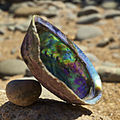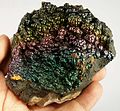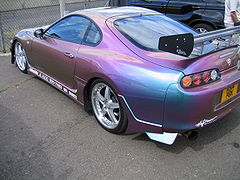Iridescence

Iridescence (also known as goniochromism) is the phenomenon of certain surfaces that appear to gradually change color as the angle of view or the angle of illumination changes. Examples of iridescence include soap bubbles, feathers, butterfly wings and seashell nacre, as well as certain minerals. It is often created by structural coloration (microstructures that interfere with light).
Pearlescence is a related effect where some or all of the reflected light is white, where iridescent effects produce only other colours. The term pearlescent is used to describe certain paint finishes, usually in the automotive industry, which actually produce iridescent effects.
Etymology
The word iridescence is derived in part from the Greek word ἶρις îris (gen. ἴριδος íridos), meaning rainbow, and is combined with the Latin suffix -escent, meaning "having a tendency toward".[1] Iris in turn derives from the goddess Iris of Greek mythology, who is the personification of the rainbow and acted as a messenger of the gods. Goniochromism is derived from the Greek words gonia, meaning "angle", and chroma, meaning "colour".
Mechanisms


Iridescence is an optical phenomenon of surfaces in which hue changes with the angle of observation and the angle of illumination.[2][3] It is often caused by multiple reflections from two or more semi-transparent surfaces in which phase shift and interference of the reflections modulates the incidental light (by amplifying or attenuating some frequencies more than others).[2][4] The thickness of the layers of the material determines the interference pattern. Iridescence can for example be due to thin-film interference, the functional analogue of selective wavelength attenuation as seen with the Fabry–Pérot interferometer, and can be seen in oil films on water and soap bubbles. Iridescence is also found in plants, animals and many other items. The range of colours of natural iridescent objects can be narrow, for example shifting between two or three colours as the viewing angle changes,[5][6] or a wide range of colours can be observed.[7]
Iridescence can also be created by diffraction. This is found in items like CDs, DVDs, some types of prisms, or cloud iridescence.[8] In the case of diffraction, the entire rainbow of colours will typically be observed as the viewing angle changes. In biology, this type of iridescence results from the formation of diffraction gratings on the surface, such as the long rows of cells in striated muscle, or the specialized abdominal scales of peacock spider Maratus robinsoni and M. chrysomelas.[9] Some types of flower petals can also generate a diffraction grating, but the iridescence is not visible to humans and flower-visiting insects as the diffraction signal is masked by the coloration due to plant pigments.[10][11][12]
In biological (and biomimetic) uses, colours produced other than with pigments or dyes are called structural coloration. Microstructures, often multilayered, are used to produce bright but sometimes non-iridescent colours: quite elaborate arrangements are needed to avoid reflecting different colours in different directions.[13] Structural coloration has been understood in general terms since Robert Hooke's 1665 book Micrographia, where Hooke correctly noted that since the iridescence of a peacock's feather was lost when it was plunged into water, but reappeared when it was returned to the air, pigments could not be responsible.[14][15] It was later found that iridescence in the peacock is due to a complex photonic crystal.[16]
Pearlescence
Pearlescence is an effect related to iridescence and has a similar cause. Structures within a surface cause light to be reflected back, but in the case of pearlescence some or all of the light is white.[17] Artificial pigments and paints showing an iridescent effect are often described as pearlescent, for example when used for car paints.[18]
Examples
Life
Arthropods and molluscs
-
The iridescent exoskeleton of a golden stag beetle
-
Structurally coloured wings of Morpho didius
-
The inside surface of Haliotis iris, the paua shell
-
Structurally coloured wings of a Tachinid fly
Chordates
The feathers of birds such as kingfishers,[19] birds-of-paradise,[20] hummingbirds, parrots, starlings,[21] grackles, ducks, and peacocks[16] are iridescent. The lateral line on the neon tetra is also iridescent.[5] A single iridescent species of gecko, Cnemaspis kolhapurensis, was identified in India in 2009.[22] The tapetum lucidum, present in the eyes of many vertebrates, is also iridescent.[23]
-
Both the body and the train of the peacock are iridescent
-
A catfish
-
The rainbow boa
Plants

Many groups of plants have developed iridescence as an adaptation to use more light in dark environments such as the lower levels of tropical forests. The leaves of Southeast Asia's Begonia pavonina, or peacock begonia, appear iridescent azure to human observers due to each leaf's thinly layered photosynthetic structures called iridoplasts that absorb and bend light much like a film of oil over water. Iridescences based on multiple layers of cells are also found in the lycophyte Selaginella and several species of ferns.[24][25]
Meat
-
Iridescence in meat, caused by light diffraction on the exposed muscle cells[26]
Minerals and compounds
-
A bismuth crystal with a thin iridescent layer of bismuth oxide
-
An engine oil spill
Man-made objects
-
Pearlescent paint job on a Toyota Supra car
-
Playing surface of a compact disc
-
iridescent glitter nail polish
-
Smartphone with iridescent back panel
Nanocellulose is sometimes iridescent,[27] as are thin films of gasoline and some other hydrocarbons and alcohols when floating on water.[28]
To create jewelry with crystal glass that lets light refract in a rainbow spectrum, Swarovski coats some of its products with special metallic chemical coatings. For example, its Aurora Borealis gives the surface a rainbow appearance.[citation needed]
See also
- Anisotropy
- Bioluminescence, irrespective of angle
- Dichroic filter
- Dichroism
- Iridocyte
- Labradorescence (Adularescence)
- Metallic color
- Opalescence
- Structural color
- Thin-film optics
- Nacre
- Opal
References
- ^ "Online Etymology Dictionary". etymonline.com. Archived from the original on 2014-04-07.
- ^ a b Nano-optics in the biological world: beetles, butterflies, birds and moths Archived 2014-09-09 at the Wayback Machine Srinivasarao, M. (1999) Chemical Reviews pp: 1935–1961
- ^ Physics of structural colours Archived 2015-02-13 at the Wayback Machine Kinoshita, S. et al (2008) Rep. Prog. Phys. 71: 076401
- ^ Meadows M.; et al. (2009). "Iridescence: views from many angles". J. R. Soc. Interface. 6: S107–S113. doi:10.1098/rsif.2009.0013.focus. PMC 2706472. PMID 19336343. Archived from the original on 2015-02-15.
- ^ a b Yoshioka S.; et al. (2011). "Mechanism of variable structural colour in the neon tetra: quantitative evaluation of the Venetian blind model". J. Royal Soc. Interface. 8 (54): 56–66. doi:10.1098/rsif.2010.0253. PMC 3024824. PMID 20554565.
- ^ Rutowski RL; et al. (2005). "Pterin pigments amplify iridescent ultraviolet signal in males of the orange sulphur butterfly, Colias eurytheme". Proc. R. Soc. B. 272 (1578): 2329–2335. doi:10.1098/rspb.2005.3216. PMC 1560183. PMID 16191648.
- ^ Saego AE; et al. (2009). "Gold bugs and beyond: a review of iridescence and structural colour mechanisms in beetles (Coleoptera)". J. R. Soc. Interface. 6: S165–S184. Archived from the original on 2015-02-15.
- ^ Meteorology By Professor of Atmospheric and Oceanic Sciences University of Wisconsin-Madison Director Cooperative Institute for Meteorological Satellite Studies (Cimss) Steven A Ackerman, Steven A. Ackerman, John A. Knox -- Jones and Bartlett Learning 2013 Page 173-175
- ^ Hsiung, Bor-Kai; Siddique, Radwanul Hasan; Stavenga, Doekele G.; Otto, Jürgen C.; Allen, Michael C.; Liu, Ying; Lu, Yong-Feng; Deheyn, Dimitri D.; Shawkey, Matthew D. (2017-12-22). "Rainbow peacock spiders inspire miniature super-iridescent optics". Nature Communications. 8 (1): 2278. doi:10.1038/s41467-017-02451-x. ISSN 2041-1723. PMC 5741626. PMID 29273708.
- ^ Nature's palette: the science of plant colour. Lee, DW (2007) University of Chicago Press
- ^ Iridescent flowers? Contribution of surface structures to optical signaling Archived 2016-09-24 at the Wayback Machine van der Kooi, CJ et al (2014) New Phytol 203: 667–673
- ^ Is floral iridescence a biologically relevant cue in plant–pollinator signaling? Archived 2017-03-05 at the Wayback Machine van der Kooi, CJ et al (2015) New Phytol 205: 18–20
- ^ Hsiung, Bor-Kai; Siddique, Radwanul Hasan; Jiang, Lijia; Liu, Ying; Lu, Yongfeng; Shawkey, Matthew D.; Blackledge, Todd A. (2017-01-15). "Tarantula-Inspired Noniridescent Photonics with Long-Range Order". Advanced Optical Materials. 5 (2): 1600599. doi:10.1002/adom.201600599. ISSN 2195-1071.
- ^ Hooke, Robert. Micrographia. Chapter 36 ('Observ. XXXVI. Of Peacoks, Ducks, and Other Feathers of Changeable Colours.')
- ^ Ball, Philip (May 2012). "Nature's Color Tricks". Scientific American. 306 (5): 74–79. doi:10.1038/scientificamerican0512-74. PMID 22550931.
- ^ a b Zi J; et al. (2003). "Coloration strategies in peacock feathers". Proc. Natl. Acad. Sci. 100 (22): 12576–12578. doi:10.1073/pnas.2133313100. PMC 240659. PMID 14557541.
- ^ Ruth Johnston-Feller (2001). Color Science in the Examination of Museum Objects: Nondestructive Procedures. Getty Publications. pp. 169–. ISBN 978-0-89236-586-9.
- ^ Paint and Coating Testing Manual. ASTM International. pp. 229–. GGKEY:7W7C2G88G2J.
- ^ Stavenga D.G.; et al. (2011). "Kingfisher feathers – colouration by pigments, spongy nanostructures and thin films". J. Exp. Biol. 214 (23): 3960–3967. doi:10.1242/jeb.062620. PMID 22071186.
- ^ Stavenga D.G.; et al. (2010). "Dramatic colour changes in a bird of paradise caused by uniquely structured breast feather barbules". Proc. R. Soc. B. 278 (1715): 2098–2104. doi:10.1098/rspb.2010.2293. PMC 3107630. PMID 21159676.
- ^ Plumage Reflectance and the Objective Assessment of Avian Sexual Dichromatism Cuthill, I.C. et al. (1999) Am. Nat. 153: 183-200 JSTOR 303160
- ^ "New lizard species found in India". BBC Online. 24 July 2009. Retrieved 20 February 2014.
- ^ Engelking, Larry (2002). Review of Veterinary Physiology. Teton NewMedia. p. 90. ISBN 978-1-893441-69-9.
- ^ Glover, Beverley J.; Whitney, Heather M. (April 2010). "Structural colour and iridescence in plants: the poorly studied relations of pigment colour". Annals of Botany. 105 (4): 505–511. doi:10.1093/aob/mcq007. PMC 2850791. PMID 20142263.
- ^ Graham, Rita M.; Lee, David W.; Norstog, Knut (1993). "Physical and Ultrastructural Basis of Blue Leaf Iridescence in Two Neotropical Ferns". American Journal of Botany. 80 (2): 198–203. doi:10.2307/2445040. JSTOR 2445040.
- ^ Martinez-Hurtado, Juan; Akram, Muhammad; Yetisen, Ali (2013). "Iridescence in Meat Caused by Surface Gratings". Foods. 2 (4): 499–506. doi:10.3390/foods2040499. PMC 5302279. PMID 28239133.
{{cite journal}}: CS1 maint: unflagged free DOI (link) - ^ Picard, G.; Simon, D.; Kadiri, Y.; LeBreux, J. D.; Ghozayel, F. (2012). "Cellulose Nanocrystal Iridescence: A New Model". Langmuir. 28 (41): 14799–14807. doi:10.1021/la302982s. PMID 22988816.
- ^ Zitzewitz, Paul W (2011). The Handy Physics Answer Book. Visible Ink Press. p. 215. ISBN 978-1-57859-357-6.
External links
- A 2.2 MB GIF animation of a morpho butterfly showing iridescence
- "Article on butterfly iridescence"









![Iridescence in meat, caused by light diffraction on the exposed muscle cells[26]](http://upload.wikimedia.org/wikipedia/commons/thumb/9/9a/Meat_Iridiscence.png/120px-Meat_Iridiscence.png)







